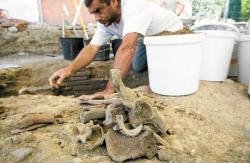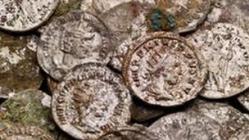INSTITUT SUPERIEUR D'ANTHROPOLOGIE
INSTITUTE OF ANTHROPOLOGY
ONLINE COURSES / COURS A DISTANCE
INSCRIPTION 2012 / Session III : Juillet 2012
REGISTRATION 2012 / Term III : July 2012
FRANCE –  Toulouse - Des dés en os ou encore des morceaux de vase décorés. Les poubelles de nos ancêtres du Moyen Âge regorgent de trésors, parfois rares comme ces vertèbres de dauphin, un mets pêché en Méditerranée, salé avant d'atterrir dans les auges des Toulousains. Les archéologues de l'Inrap*, qui ont travaillé durant six mois sur le futur site de l'école d'économie, derrière Saint-Pierre-des-Cuisines, ont livré jeudi les premières conclusions de leurs fouilles. « La première occupation du site est de type funéraire, au IIIe-IVe siècle de notre ère, avec une nécropole à inhumations comportant plus de 200 tombes », relève Jean Catalo, le responsable. Mais l'une des plus grandes trouvailles reste l'angle d'un bâtiment wisigothique du Ve siècle, qui devait mesurer 50 m sur 40. « C'est peut-être un mausolée, mais quelle que soit sa fonction, cela prouve que pour le pouvoir public, Toulouse était une capitale », souligne l'archéologue.
Toulouse - Des dés en os ou encore des morceaux de vase décorés. Les poubelles de nos ancêtres du Moyen Âge regorgent de trésors, parfois rares comme ces vertèbres de dauphin, un mets pêché en Méditerranée, salé avant d'atterrir dans les auges des Toulousains. Les archéologues de l'Inrap*, qui ont travaillé durant six mois sur le futur site de l'école d'économie, derrière Saint-Pierre-des-Cuisines, ont livré jeudi les premières conclusions de leurs fouilles. « La première occupation du site est de type funéraire, au IIIe-IVe siècle de notre ère, avec une nécropole à inhumations comportant plus de 200 tombes », relève Jean Catalo, le responsable. Mais l'une des plus grandes trouvailles reste l'angle d'un bâtiment wisigothique du Ve siècle, qui devait mesurer 50 m sur 40. « C'est peut-être un mausolée, mais quelle que soit sa fonction, cela prouve que pour le pouvoir public, Toulouse était une capitale », souligne l'archéologue.
http://www.20minutes.fr/article/944751/sous-pieds-economistes-capitale-barbare
JORDANIE –  - Qusayr ’Amra - Recent conservation work at Qusayr ’Amra, a UNESCO World Heritage Site 85 kilometers east of Amman, has revealed the name of the Umayyad prince who commissioned the construction of the building. The site is a small building dating to the Umayyad period and is known for its mural paintings. Gazelle and wild donkey hunts, dances, musicians, court scenes and allegories, and zodiac symbols are all painted on interior surfaces. The inscription, which previously could not be read due to accumulated dirt and previous unsuccessful cleaning attempts, is an invocation to Allah beginning with the formula “Allahumma aslih al-Walid ibn Yazîd” (“Oh God! Make al-Walîd ibn Yazîd virtuous”). This inscription was painted in white above a window in old Kufic alphabet without any diacritical dots. Sections of the three-line inscription are still being translated. Walid Ibn Yazid, or Walid II, was an Umayyad caliph who reigned for a little over a year, from February 743 to April 744. The inscription, however, is missing the typical expressions used for Umayyad caliphs (“God’s servant,” “Prince of the Believers”), indicating that it was painted when Walid was still a prince, during the reign of Hisham bin Abd el-Malik (723–743). The current conservation campaign at Qusayr ’Amra began in 2009 with the goals of consolidating the structure and cleaning the mural paintings. The latter activity is revealing brilliant colors and unexpected details that can be seen now for the first time, almost 1,300 years after the site was abandoned following the Abbasid revolution, which resulted in the defeat of the Umayyads in 750.
- Qusayr ’Amra - Recent conservation work at Qusayr ’Amra, a UNESCO World Heritage Site 85 kilometers east of Amman, has revealed the name of the Umayyad prince who commissioned the construction of the building. The site is a small building dating to the Umayyad period and is known for its mural paintings. Gazelle and wild donkey hunts, dances, musicians, court scenes and allegories, and zodiac symbols are all painted on interior surfaces. The inscription, which previously could not be read due to accumulated dirt and previous unsuccessful cleaning attempts, is an invocation to Allah beginning with the formula “Allahumma aslih al-Walid ibn Yazîd” (“Oh God! Make al-Walîd ibn Yazîd virtuous”). This inscription was painted in white above a window in old Kufic alphabet without any diacritical dots. Sections of the three-line inscription are still being translated. Walid Ibn Yazid, or Walid II, was an Umayyad caliph who reigned for a little over a year, from February 743 to April 744. The inscription, however, is missing the typical expressions used for Umayyad caliphs (“God’s servant,” “Prince of the Believers”), indicating that it was painted when Walid was still a prince, during the reign of Hisham bin Abd el-Malik (723–743). The current conservation campaign at Qusayr ’Amra began in 2009 with the goals of consolidating the structure and cleaning the mural paintings. The latter activity is revealing brilliant colors and unexpected details that can be seen now for the first time, almost 1,300 years after the site was abandoned following the Abbasid revolution, which resulted in the defeat of the Umayyads in 750.
http://www.artdaily.org/index.asp?int_sec=2&int_new=55730
ROYAUME UNI – 
 Bath - The Beau Street Hoard of more than 20,000 silver coins was found in a stone-lined box by archaeologists working in Bath in 2007. Work has begun at the British Museum to clean them. Stephen Clews, manager of the Roman Baths, said a coin from 32BC was the oldest identified so far. British Museum conservator Julia Tubman said the coins were initially estimated to number about 30,000, but having excavated the soil block they were contained in, she believes there are no more than 22,000. Discovered about 150 yards from the Roman Baths, the hoard is described as the fifth largest ever found in the UK.
Bath - The Beau Street Hoard of more than 20,000 silver coins was found in a stone-lined box by archaeologists working in Bath in 2007. Work has begun at the British Museum to clean them. Stephen Clews, manager of the Roman Baths, said a coin from 32BC was the oldest identified so far. British Museum conservator Julia Tubman said the coins were initially estimated to number about 30,000, but having excavated the soil block they were contained in, she believes there are no more than 22,000. Discovered about 150 yards from the Roman Baths, the hoard is described as the fifth largest ever found in the UK.
http://www.bbc.co.uk/news/uk-england-somerset-18280324
INDE – Hyderabad - Badshahi Ashoorkhana is one of the earliest constructions of the Qutb Shahi period. The house of mourning was built by Mohammed Quli Qutb Shah in 1594, three years after Charminar. A classic example of Indo-Iranian architecture, Badshahi Ashoorkhana is known for its exquisite enamel tile work which still retains its lustre. Over the years the rundown structures on its premises like Naqarkhana and Niyazkhana have suffered damage. The heritage monument doubled as an auction house for years. It was only recently that the Department of Archaeology and Museums has cleared it of all encroachments on court orders.
Hyderabad - Badshahi Ashoorkhana is one of the earliest constructions of the Qutb Shahi period. The house of mourning was built by Mohammed Quli Qutb Shah in 1594, three years after Charminar. A classic example of Indo-Iranian architecture, Badshahi Ashoorkhana is known for its exquisite enamel tile work which still retains its lustre. Over the years the rundown structures on its premises like Naqarkhana and Niyazkhana have suffered damage. The heritage monument doubled as an auction house for years. It was only recently that the Department of Archaeology and Museums has cleared it of all encroachments on court orders.
http://www.thehindu.com/news/cities/Hyderabad/article3479323.ece
TURQUIE –  Troie - A team of German archaeologists, conducting excavations for nearly 25 years in the ancient city of Troy in Turkey’s northwest, are set to turn over their positions to U.S. archaeologists. The German team is leaving the excavations to the Americans because of financial problems, Professor Ernst Pernicka, the head of the excavation team, said. German archaeologists were still interested in the excavations at Troy, but Turkey wanted the site’s excavations to eventually be carried out by Turkish archaeologists, Pernicka said. The most interesting archaeological find in Troy would be to uncover a cemetery, Pernicka said. “There must definitely be a big cemetery in a city with a population of thousands. But such a cemetery has yet to be discovered.”
Troie - A team of German archaeologists, conducting excavations for nearly 25 years in the ancient city of Troy in Turkey’s northwest, are set to turn over their positions to U.S. archaeologists. The German team is leaving the excavations to the Americans because of financial problems, Professor Ernst Pernicka, the head of the excavation team, said. German archaeologists were still interested in the excavations at Troy, but Turkey wanted the site’s excavations to eventually be carried out by Turkish archaeologists, Pernicka said. The most interesting archaeological find in Troy would be to uncover a cemetery, Pernicka said. “There must definitely be a big cemetery in a city with a population of thousands. But such a cemetery has yet to be discovered.”
http://www.hurriyetdailynews.com/german-team-leaves-ancient-site.aspx?pageID=238&nID=21959&NewsCatID=375